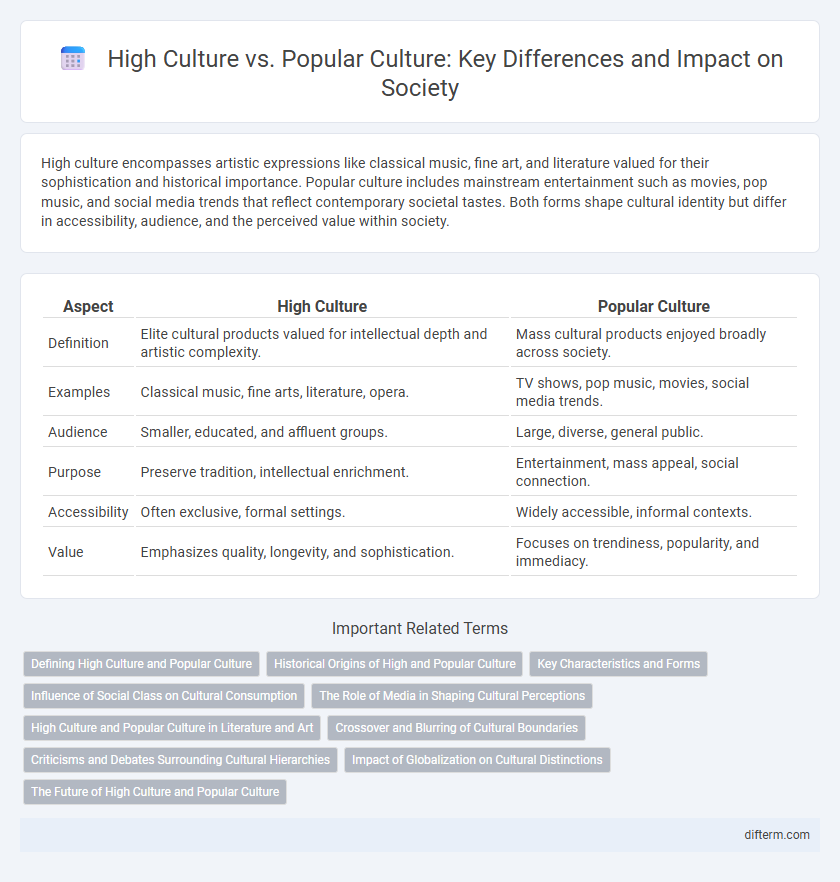High culture encompasses artistic expressions like classical music, fine art, and literature valued for their sophistication and historical importance. Popular culture includes mainstream entertainment such as movies, pop music, and social media trends that reflect contemporary societal tastes. Both forms shape cultural identity but differ in accessibility, audience, and the perceived value within society.
Table of Comparison
| Aspect | High Culture | Popular Culture |
|---|---|---|
| Definition | Elite cultural products valued for intellectual depth and artistic complexity. | Mass cultural products enjoyed broadly across society. |
| Examples | Classical music, fine arts, literature, opera. | TV shows, pop music, movies, social media trends. |
| Audience | Smaller, educated, and affluent groups. | Large, diverse, general public. |
| Purpose | Preserve tradition, intellectual enrichment. | Entertainment, mass appeal, social connection. |
| Accessibility | Often exclusive, formal settings. | Widely accessible, informal contexts. |
| Value | Emphasizes quality, longevity, and sophistication. | Focuses on trendiness, popularity, and immediacy. |
Defining High Culture and Popular Culture
High culture encompasses elite art forms such as classical music, fine arts, and literature, distinguished by their historical significance and intellectual depth. Popular culture includes mass-produced entertainment like television shows, pop music, and social media trends, accessible and widely consumed across diverse demographics. These cultural categories often reflect differing social values, educational levels, and modes of cultural consumption.
Historical Origins of High and Popular Culture
High culture originated in the aristocratic and intellectual circles of ancient Greece and Rome, where literature, philosophy, and fine arts were highly valued as markers of social status and education. Popular culture emerged from the traditions, customs, and daily practices of common people, evolving through folk tales, music, and street performances in medieval and early modern societies. The historical divergence between high and popular culture reflects class distinctions, with high culture associated with elite education and popular culture rooted in communal and grassroots expression.
Key Characteristics and Forms
High culture is characterized by its association with elite or classical art forms such as opera, classical music, fine arts, and literature, often requiring specialized knowledge for full appreciation. Popular culture encompasses mass-consumed entertainment like television shows, pop music, movies, and social media trends, reflecting contemporary societal values and everyday life. Key forms of high culture include museum exhibitions and symphony performances, while popular culture thrives through digital platforms, commercial media, and widespread community engagement.
Influence of Social Class on Cultural Consumption
Social class significantly shapes cultural consumption, with high culture often associated with elite preferences for classical music, fine arts, and literature, reflecting educational and economic capital. Popular culture tends to resonate more with working and middle classes, emphasizing accessible media like television, pop music, and mainstream sports. This stratification in cultural tastes reinforces social distinctions and influences cultural capital distribution within society.
The Role of Media in Shaping Cultural Perceptions
Media plays a crucial role in shaping cultural perceptions by amplifying certain narratives within high culture and popular culture, influencing public understanding and values. Through selective representation and widespread distribution, media platforms reinforce cultural hierarchies and contribute to the construction of cultural identity. This dynamic interaction between media and culture affects societal attitudes towards art, tradition, and modernity.
High Culture and Popular Culture in Literature and Art
High culture in literature and art emphasizes classical works, canonical authors, and fine arts traditionally valued for their intellectual depth and aesthetic complexity, such as Shakespearean plays and Renaissance paintings. Popular culture features mass-produced, accessible works that resonate with a broad audience, including graphic novels, pop music, and street art, often reflecting contemporary social issues and trends. The interplay between high culture and popular culture shapes evolving artistic expressions and influences societal perceptions of cultural value.
Crossover and Blurring of Cultural Boundaries
High culture and popular culture increasingly intersect, resulting in a dynamic crossover where classical art forms influence contemporary media and vice versa. This blurring of cultural boundaries fosters innovation, as elements such as opera, literature, and fine art integrate with music, film, and digital platforms. The fusion challenges traditional hierarchies, making cultural experiences more accessible and diverse across social groups.
Criticisms and Debates Surrounding Cultural Hierarchies
Criticisms of cultural hierarchies center on the perceived elitism of high culture, which is often seen as privileging Western classical arts and excluding diverse cultural expressions. Debates highlight how popular culture challenges traditional distinctions by democratizing access to art forms, but it faces accusations of being overly commercialized and lacking depth. Scholars argue that rigid cultural hierarchies reinforce social inequalities and advocate for more inclusive frameworks that recognize varied cultural contributions.
Impact of Globalization on Cultural Distinctions
Globalization has increasingly blurred the boundaries between high culture and popular culture, facilitating the cross-cultural exchange of art, music, and literature on a global scale. The widespread accessibility of digital media platforms enables traditional elite cultural forms to reach broader audiences while popular culture adapts and incorporates diverse cultural influences. This dynamic interaction challenges the exclusivity once associated with high culture, leading to a more interconnected and hybrid cultural landscape worldwide.
The Future of High Culture and Popular Culture
High culture and popular culture continue to evolve with technology, influencing how society values art, literature, and entertainment. Digital platforms and social media democratize access to cultural forms, challenging traditional hierarchical distinctions between high and popular culture. Emerging trends indicate increased blending, where classical art and mass media intersect to create hybrid cultural experiences that appeal to diverse audiences.
high culture vs popular culture Infographic

 difterm.com
difterm.com